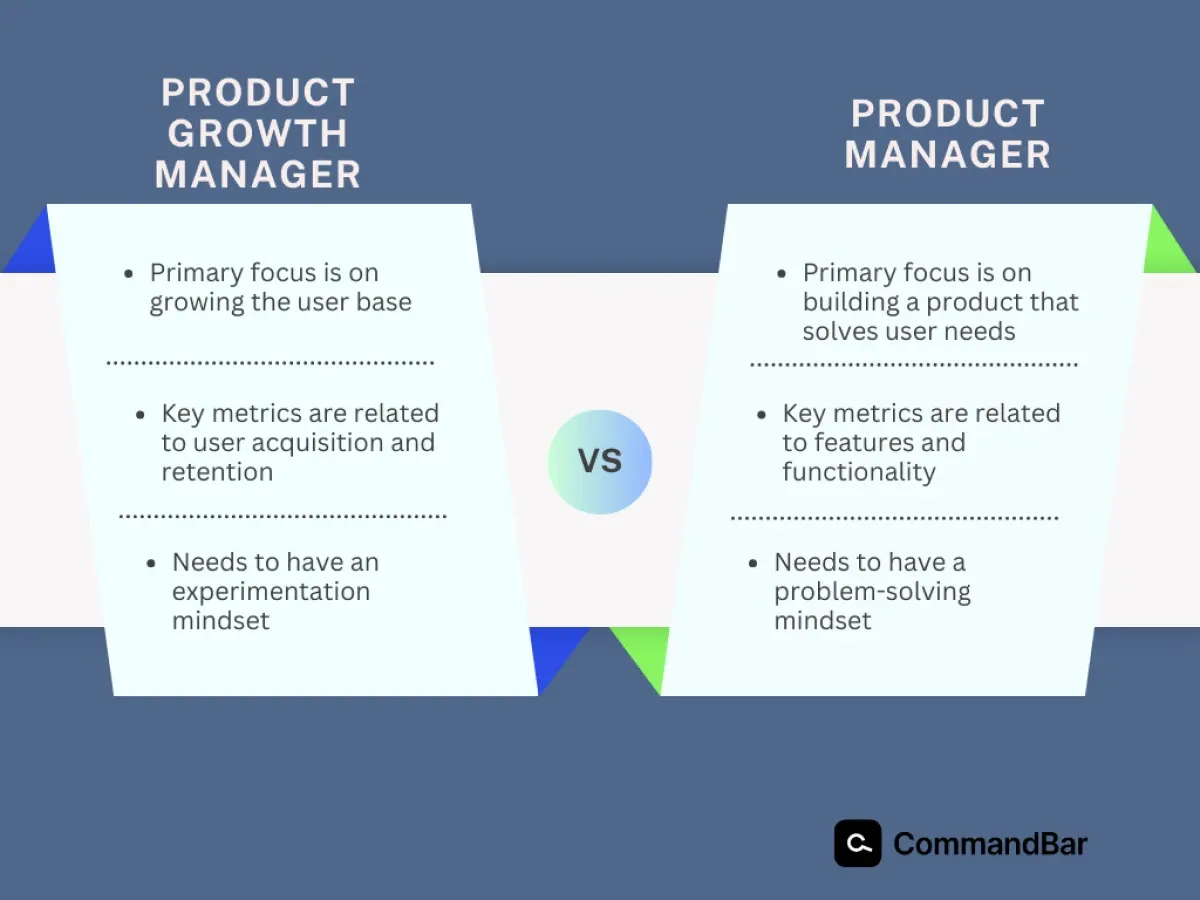Imagine yourself as a gardener, pouring your heart into a seed, meticulously nurturing it, only to have a spindly sapling emerge. Disappointing, right? Launching a SaaS product can feel eerily similar. You plant the seed of your idea, invest time and effort, but instead of a flourishing user base that craves to use your product, you're left with a trickle of growth, a far cry from the explosion you envisioned.
Forget slow, steady growth. Product growth is the “fertilizer” your product needs to acquire new users, fuel engagement, and keep them coming back for more.
Think of it like this – product managers are the architects who design the perfect building i.e. the product. Product marketers are the real estate agents, shouting from the rooftops about its awesomeness. And the product growth manager? He is like the community manager who helps to cultivate a thriving community of residents who love the building, stay in it, and keep coming to use all the different facilities.
Now, you might be thinking, "Isn't that what product managers and marketers already do?" Well, there's some overlap for sure. But product growth managers have a laser focus on one thing – scaling user growth in a measurable and data-driven way. In short, they're the experimenters, the analysts, and the strategists who constantly tweak, test and iterate to make sure your product reaches its full potential by tapping into its user base.
Demystifying the product growth manager role
Product growth managers are obsessed with two things – getting new users through the door and then making sure they have an "aha!" moment that keeps them coming back for more. They're the masterminds behind those smart onboarding flows and irresistible features that turn casual sign-ins into regular and loyal users.

Growth experimentation is a big part of the product growth manager’s role. Think A/B testing different headlines, signup forms, or app features to see what resonates best with users. It's a constant cycle of hypothesizing, testing, analyzing, and iterating – all based on data.
It’s all about optimizing the user journey – from the first moment as user registers to use your product to every subsequent sign-in (or reluctance of it). In addition, to boost SERPs rankings, conduct a competitor backlink analysis and build your own strong backlink profile.
Being a product growth manager means befriending numbers. You need to sift through mountains of data – tracking user behavior, clicks, drop-offs, funnel movement – all to figure out the trends and the impact of growth initiatives. Product growth managers need to have a user-centric mindset. There can be more than one persona, especially in B2B contexts, that you may need to target differently. And of course, taking all that data and using it, not just for devising growth experiments but also making sure everyone from product managers to product marketers understands them, becomes critical.
How product growth compares to product management and product marketing
Let's face it, the world of product development has a lot of moving parts, and traditionally, product managers and product marketers together took on the task of optimizing user journeys. So how does a product growth manager fit into the scene?

A product manager is an architect – prioritizing and designing the features and functionalities that make the product useful and amazing for users. They focus on solving user needs, or shall we say, getting the product on the shelf.
A product marketing manager is the communicator whose job is to get the product off the shelf. They come up with the product value proposition and target messages to appeal to customers, to encourage the generation of new business and product adoption.
A product growth manager is all about user activation, engagement, and retention. Basically, once a SaaS product has been sold, it is important to get users to keep coming back to the product and engage with the different features.
While their goals differ, success hinges on close collaboration between the product growth manager, product manager, and product marketer. Both product growth managers and product managers need a deep understanding of user needs and motivations. This shared knowledge helps them build a product that users love and perfect the user journey to maximize engagement. Strong communication is crucial for all three roles. Product growth managers translate data insights for product managers and marketers, while product managers ensure features align with the user acquisition strategy. Marketers, in turn, use this knowledge to come up with targeted messages that resonate with users.
Framing success as a product growth manager
Let’s take a look at what the product growth framework looks like.
Knowing your north star
Product growth goals should be ambitious yet achievable, and most importantly, aligned with the overall business objectives. Translating these goals into actionable metrics is key. These could mean monitoring daily active users, conversion rates, or churn rates – depending on what the focus of the business is.
Define SMART goals: Set specific, measurable, attainable, relevant, and time-bound, or in other words, SMART goals that align with the overall business objectives. For example, the product growth manager might aim to increase daily active users by 20% within the next quarter.

Identify key metrics: Translate your goals into actionable metrics that tell you if you're on the right track. These might include:
- Acquisition metrics: Track website traffic, leads generated, and sign-up rates to understand how well you're attracting new users.
- Activation metrics: Monitor free trial conversions, feature adoption rates, and time-to-value to see whether users are getting value from your product.
- Retention metrics: Track daily active users (DAU), churn rate, and customer lifetime value (CLTV) to gauge user engagement and long-term success.
Make data-driven decisions: Regularly analyze your data to identify trends, optimize your growth strategies, and make data-driven decisions that fuel growth.
Casting the user acquisition net
The first step is always to attract new users.
Organic channels like content marketing and practices from an SEO checklist can build brand awareness and attract users who are already searching for solutions like yours.
- Content marketing: Create valuable content like blog posts, webinars, and ebooks that address user pain points and establish your brand as a thought leader.
- Search engine optimization (SEO): Optimize your website and content for relevant keywords to improve organic search ranking and attract users who are actively searching for solutions like yours.
Paid advertising can be a powerful tool to reach a wider audience, but it requires careful targeting and budget management. And, also decide: Is in-house SEO worth it or should you do SEO outsourcing to boost your organic rankings and engage users? There is a wide variety of SEO agencies familiar with Startups who'd gladly discuss your brand's individual needs."
- Targeted advertising: Utilize platforms like Google Ads or social media advertising to reach a wider audience with campaigns focused on your target demographics and interests.
- Affiliate marketing: Partner with relevant thought leaders or websites to promote your product and drive qualified traffic to your signup funnel.
From user activation to onboarding
User onboarding is the first impression you have to turn curious first-timers into active users. Clear demos, helpful walkthroughs, and help center articles can all help users see the value proposition of your product, which ultimately become key ingredients for successful activation.
- Frictionless sign-up: Make the signup process quick and easy, minimizing barriers to entry.
- Engaging onboarding flow: Guide users through a step-by-step process that showcases your product's value proposition and helps them experience the "aha!" moment faster.
- Personalized experience: Tailor the onboarding experience based on user type or signup source, ensuring it's relevant and valuable.
Keeping them hooked
They've signed up and they're using the product – but the real challenge is keeping users coming back for more. This is where user retention strategies come into play.
- Building value: Continuously develop features and functionalities that address user needs and provide ongoing value.
- User engagement initiatives: Implement loyalty programs, gamification elements, and exclusive content to keep users engaged and coming back for more.
- Proactive communication: Stay connected with your users through personalized emails, in-app messages, and a robust knowledge base to provide ongoing support and guidance.
Product growth managers are the fuel behind the growth engine
The world of B2B SaaS is full of challenges. Acquiring users is just step one. Keeping those users coming back is another battle. The growth product manager role is most valuable in product-led organizations, where the focus is on creating an exceptional user experience that drives growth. The best product growth managers cultivate a growth mindset, embracing challenges, learning from failures, and constantly experimenting to optimize and improve the user journey.
Theirs is also a highly collaborative role. Product growth managers need to work very closely with product managers and product marketers to bring a product to market successfully and to wow users. Ultimately they form a part of a dream team, a united front working towards a single goal: building a thriving product that users love.

















